


Zapatistas Showcase Their Autonomous School System to the Nation and the World
Refusing Government Money or Teachers, Indigenous Communities Have Built More Schools and Educated More Children Than Ever Before
By Amber Howard
Special to The Narco News Bulletin
January 6, 2007
When the Zapatista Army of National Liberation (EZLN, in its Spanish initials) began the public phase of its struggle on New Year’s Eve, 1993, it made eleven demands, one of which was “education” (the others were: work, land, shelter, food, health, independence, freedom, democracy, justice, and peace). Thirteen years later, they have seen that demand met as never before in the highlands and jungles of Chiapas. But it was not the Mexican government or any other institution that complied. They did it for themselves.
 Foto: D.R. 2007 Gerardo Osuna |
On December 31, 2006, thousands of Zapatistas and visitors from throughout Mexico and the world met in the mountain town of Oventic for the Gathering of the Zapatista Peoples and the Peoples of the World, where an entire session was dedicated to “The Other Education” and civilian authorities from throughout EZLN territory explained what they have done, and what they still hope to do.
The main idea behind the creation of the Other Education is to teach the youth the history, language and culture of the people, and educate them to provide for their community, something that the government was never able to do. Representatives Lucio and Magdalena spoke from Caracol II (“caracol” is the term used to describe five governmental centers of the EZLN), with its seat in Oventic. They explained: “Because of the poor quality of government education, we have begun to create our own. The model of education from the government served only to destroy the mother earth and all of humanity, to develop studies favoring the interests of those in power.”
They desired a model of education which would keep their youth close to their communities and productive for the common good. “The government didn’t give us our schools, we had to construct them ourselves, since 1998. These schools aren’t recognized by the government. They are for our people here in the forest. It has cost us a lot, but they are growing,” says Gustavo, from Caracol III, with its seat in La Garrucha.
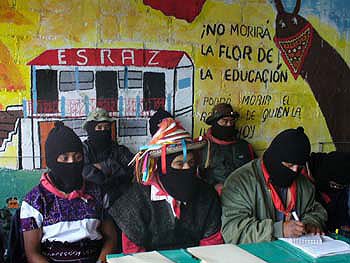 Foto: D.R. 2007 Gerardo Osuna |
While creating autonomous education has it’s challenges, and the Zapatista comandantes say that it is formed from below, by the people of the communities, learning as they go. “We learn as we walk, side by side with our education,” explains Concepciòn from Caracol V, its seat in Roberto Barrios. “We began to think, what would our education look like?”
One of the most important aspects of the Other Education is to recover cultural values, the ways of speaking and understanding each other within communities. This is something that was lost with the government education and that people are very excited to initiate again, especially through the native languages Tzotzil, Tzeltal, Tojolabal and Chol, among others. It is essential that the classes are taught in the local native language, not only because of the cultural significance, but because this is the language spoke primarily in the home and in which their children can best understand.
As 18-year-old local graduate, Lucio, explains “We speak our own language. We are in resistance. Our education teaches us what is neo-liberalism, what it means to be autonomous. The government teachers often didn’t show up, because they said they weren’t well paid. They tried to tell us to look for work alone, to not struggle or resist against the government. But we believe that we do everything for everyone. We have to do it together.”
In addition to the importance of learning about the local history, culture and language, the representatives of Caracol III also brought up the critical need for environmental studies and gender equality through education. “The environment is the fountain of life. We must learn about conservation of bio-diversity. We believe in an environmental education that supports the care of our Mother Earth in a conscious, critical and reflective way. We want to teach solutions. We also want our children to learn about freedom, dignity and to value human beings, both men and women.”
The four main areas of study in the Other Education are:
- History: of the local region, the Zapatista struggle, Mexico and the world.
- Language: local languages and Spanish.
- Math, and;
- Agro-Ecology- how to take care of the environment through practices of organic agriculture and rejection of trans-genetic seeds, among other methods.
The students also learn about ways to provide for their communities while in school, such as growing gardens, how to produce crops, problems with the Earth and how to raise animals such as chickens, sheep and pigs. In this way they are able to learn practical knowledge and also gain income to support the “promoters of education,” (the Zapatista term for teacher), who are local, unpaid and do the work out of their own desire to raise the consciousness in their communities.
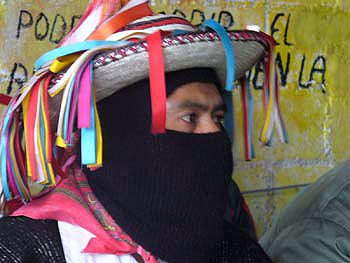 Foto: D.R. 2007 Gerardo Osuna |
These promoters are trained by professionals, and then turn around and train another generation of local promoters from their communities. It’s important to note that these promoters are learning alongside their students. It’s not the type of education where the teacher knows everything, and the students know nothing. Rather, they are promoters, people from within the community committed to promoting different types of work and knowledge. As a representative from Caracol I describes, “We’ve created 72 new autonomous schools, and trained 20 educational promoters. These 20 promoters then in turn trained another 80 promoters, becoming the first generation of our autonomous education. We are now in the 3rd generation of promoters and have 147 promoters working with 1,726 students.”
Within the schools, the students aren’t organized by grades, nor are they evaluated by tests or given final scores, the typical practice in government schools. Instead, if there are numerous promoters in a particular community, the children are divided by age and level of knowledge. But, in many cases there is just one promoter per community and there is no division of students, but rather a multi-level classroom in which the older students also teach the younger ones. This is much different from the government schools, where in many cases the indigenous children were marginalized, made fun of, and punished for speaking their native language. There was no appreciation of the richness of different people and their different ways of being.
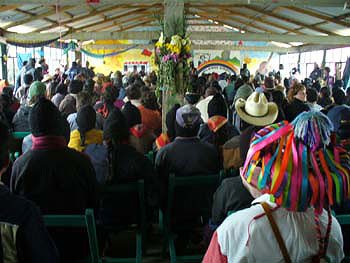 Foto: D.R. 2007 Gerardo Osuna |
To the Zapatistas, this means that the students, after finishing middle school, address the urgent needs within the community and help to educate others. Students are taught how to generate production and food, giving them work in farming, arts, health, what the people of the area need, rather than some distant far off future. Since the autonomous education isn’t recognized outside the rebel territory, graduates aren’t able to continue their studies. As one parent, Diego, recounts, “My son graduated last year from the local Rebellious Autonomous Middle School, “Escuela Secundaria Rebelde Autonoma Zapatista”, the first one created in rebel territory, in Oventic. He wanted to go on to study but since he couldn’t, he ended up working at the primary school as a teacher.” One of the biggest dreams of the Other Education is to one day have an autonomous high school and university, so that students will be able to further their education.
Although the communities have continued with passion to provide the Other Education to their children, it has not been without a struggle. Many adults don’t know how to read or write. This is one reason it is difficult to find promoters that come from the same communities. Also, many times promoters are unable to continue teaching or training others. Because of the need to provide for their families, to buy clothes or food, few make through the completion of the training, leaving many still without consistent education.
Another difficulty is the lack of resources. Once it was decided to construct everything from below, without help from the government, it has been often a struggle to put together materials to build schools and provide for the students. “We have a lot more that we want to build, but can’t because we have no resources.” But it is worth it to have the freedom of autonomous education, say representatives of Caracol IV. “We can give classes to our children in a house or under a tree, in doesn’t matter. We don’t need the money any more from the bad government. We see how to help our own promoters and therefore help all the people of the community.”
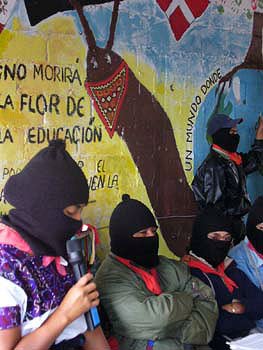 Foto: D.R. 2007 Gerardo Osuna |
The Other Education is based in the construction of a new world, with values of being, not of having. The Zapatistas believe in being realistic: figuring out what the community truly needs for its own liberation, and educating students around this discovery. Even with all of the shortcomings or challenges, as Comandante Concepción from Caracol IV sums up, “Education here is our own. As Zapatistas, we began to organize ourselves here in our territory, and it has caused us problems. But it’s just not the same, the education that the government gives, and we began to realize this. They forced us to learn whatever they wanted, and we began to resist. The education they were giving to our children wasn’t good. We had to make the change, to create the Other Education.”
This dialogue with representatives from the different caracoles was one of the first public glimpses for many into the autonomous, rebellion world of the Zapatista communities. With an audience so full of people from around the world that it overflowed the school, the meeting had to be moved outside for more space. It was an opportunity to see the blending of locals with black masks and intricate embroidery, with students, teachers and others from across the world, all together to witness the presentation of an alternative to the capitalistic, government system, what can be done when the people from below unite to provide for their community.
Many people, including Beatriz Gutierrez, an indigenous teacher from Oaxaca, are anxious to take these presentations to the next level. “I want to see past the words and really see how it is in the classroom.” She suggested having a specifically educational meeting, in which teachers would unite with a group of 15 students, and demonstrate the ways they work in their own classrooms, in this way create another form of training. Other people proposed smaller group meetings to learn from the varied experiences of the many participants. Regardless, as Gustavo, a local Zapatista put it “There is no standard, no book that can be written about the right way to educate around the world. Each community is different. We will continue to learn, to share our ways with the people who come to listen.”
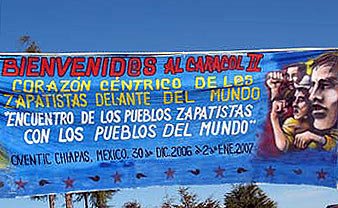 Foto: D.R. 2007 Gerardo Osuna |
Click here for more Narco News coverage of Mexico
Lea Ud. el Artículo en Español
Lisez cet article en français
- The Fund for Authentic Journalism
For more Narco News, click here.




